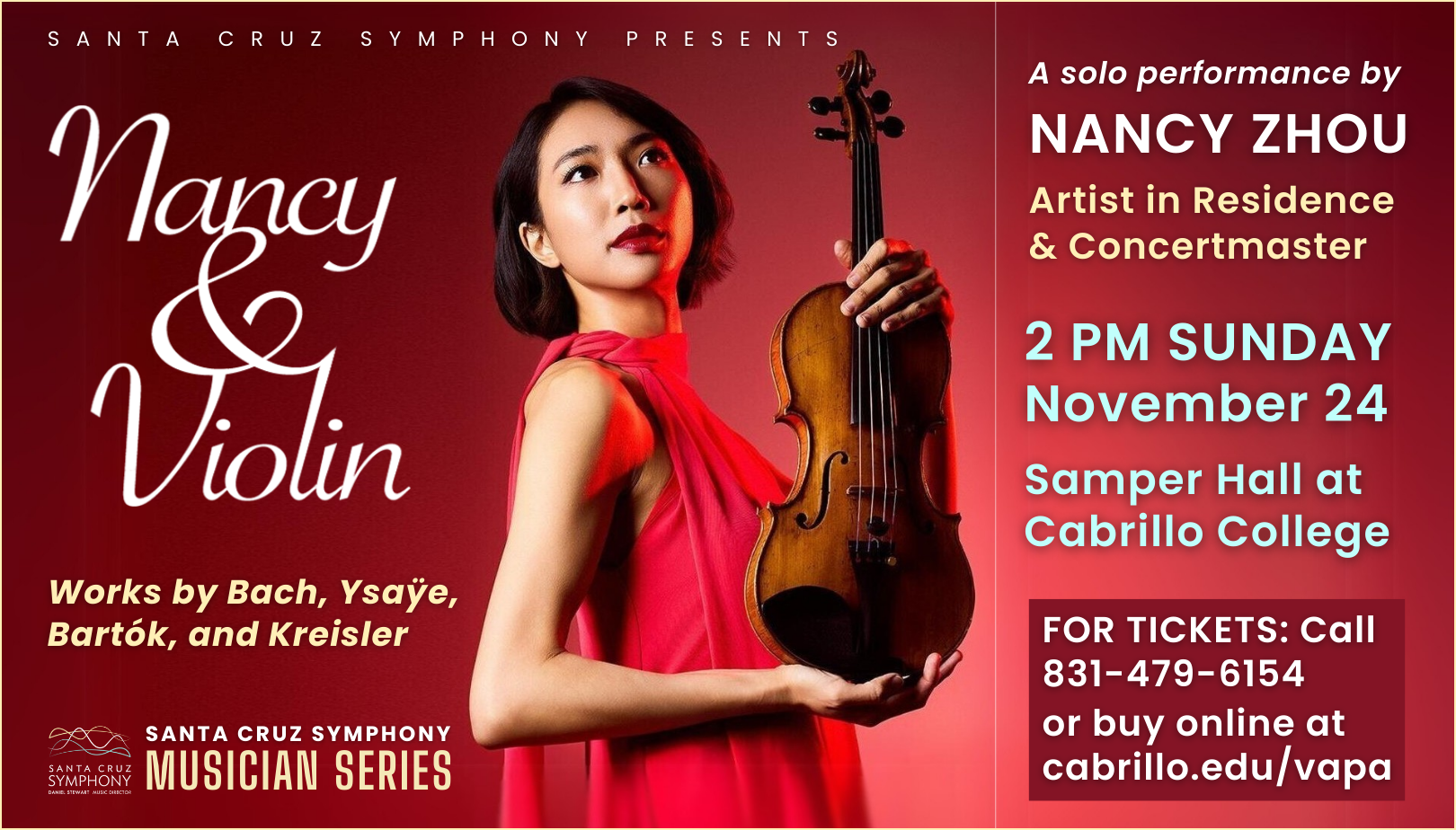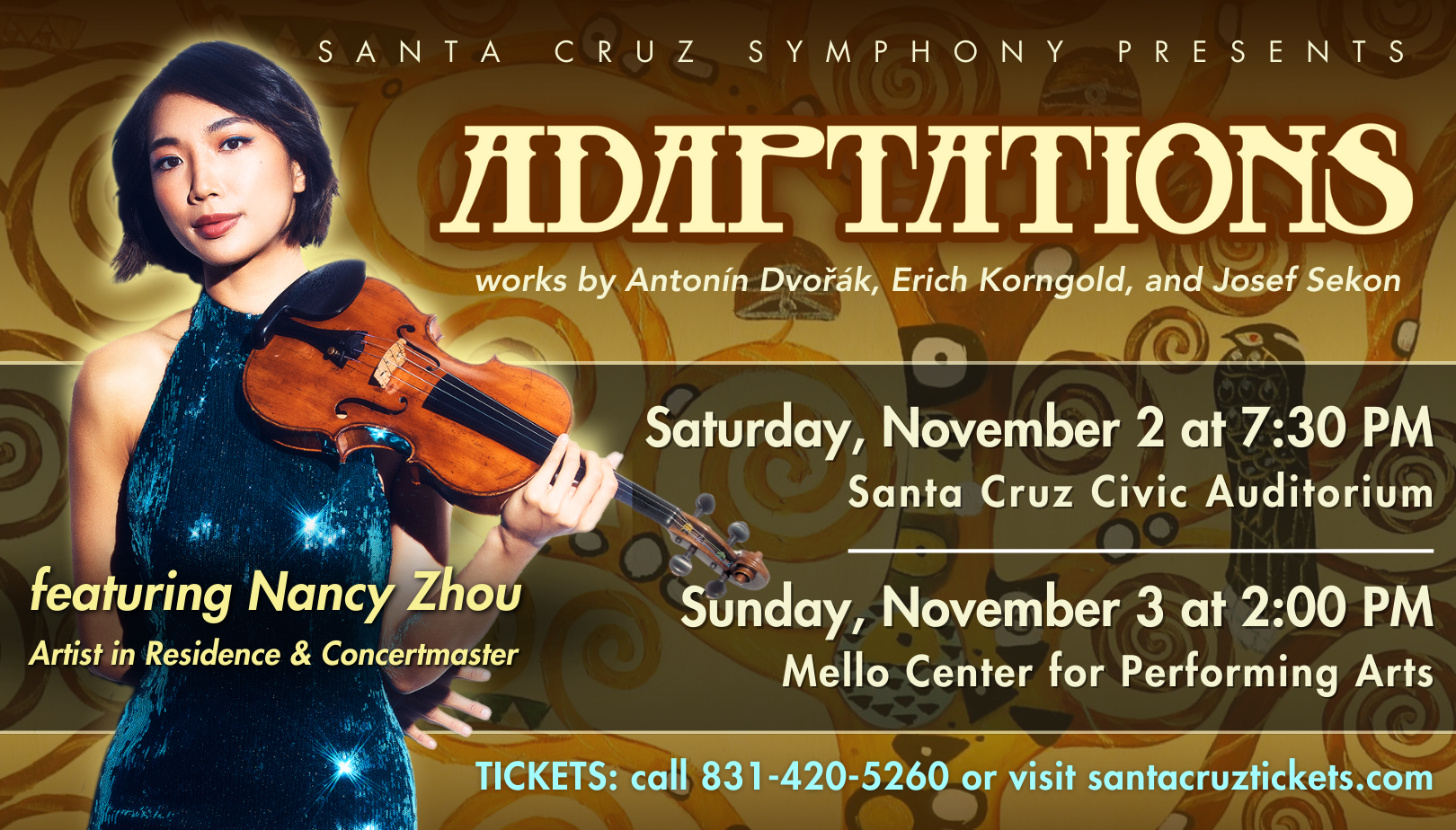To start its November concerts the Santa Cruz Symphony took audiences for a spin with the world premières of a new work by local composer Josef Sekon – a work simply called Spin. As a student, Sekon was fortunate to be able to participate in seminars by some of the biggest names in atonal music of the second half of the 20th century, Karlheinz Stockhausen and Pierre Boulez. Spin reflects this heritage.
Professor Martin Gaskell
In the 2021-2022 season the orchestra premiered another work by Sekon, his Aptos Sound Project, consisting of five diverse portraits of Aptos and Santa Cruz. These included a ghostly depiction of the cement ship on Seacliff State Beach at midnight, tango dancing in Aptos, and Halloween hysteria on Pacific Avenue. In contrast to this, Spin is a unified movement of 13-minutes duration. As the program note insert explained, the title is meant to conjure up emotions associated with spinning of all sorts including taking a fast car for a spin. (The composer suggested that ideally the car should be a bright red Lamborghini!) Going up in a space shuttle was another suggestion.
The sounds of Spin are a combination of various types of mechanical spinning on earth and emotions of space travel. However, as Kiefer Taylor joked in his excellent pre-concert talks, the car must have been travelling to Aptos on Hwy 1 on a weekday late afternoon, because sometimes the car came to complete halts! These static moments serve as important structural indicators in the piece. They include impressive, sustained, swelling, brass sonorities, held string sounds, and the music fading away to moments of complete silence before starting to spin again.
Spin started abruptly with a jolt. At first the listener’s attention was drawn to the fascinating pallet of sounds, such the gong, tubular bells, Wuhan cymbals, and fleeting woodwind fragments. Big, slow, static crescendi and decrescendi of the full brass appeared. After a second one dies away to a general silence, the strings get underway with the spinning. Traffic on Hwy 1 was finally moving!
Novel and striking string textures are an important part of the piece. This first section of motion dies away to a rumbling tremolo on the double basses and another moment of silence. Repeated double bass pizzicati on the same note underlay a wonderfully orchestrated pizzicato passage for the all the other strings. This was my favorite section. The music was now thoroughly tonal for a while. I felt like I was in a car now riding on the open road up Hwy 1 north of Santa Cruz. The pizzicati rose up and faded away to silence again. The brass slowly swelled and died away again.
This transitioned into a tremolo on the strings who were off spinning again. This time there was a spinning violin solo, played by concertmaster Yulee Seo on top of the general string motion. The spinning came to another standstill, and we got the swelling held brass sonorities again. This was followed by a long, held, harmonious, two-part major third in the violins. The spinning started up again with a tremolo scale on the low cellos that repeated over and over again. The whole string section and the solo violin got going once more.
Along with the aforementioned pizzicato section, the ending of Spin was undoubtedly its other most memorable feature. It contained some very original string writing. An eerie unworldly landscape was being depicted. The strings produced some unearthly slides to tremolos that died away to be almost inaudible. There was no more spinning. The thin sound was very static. Then a remarkable slow scraping by the strings began. Their bows were very slowly drawn across the strings with great pressure. There was no rhythmic motion, just a long, drawn-out crescendo. The woodwinds and brass joined in to give what felt like an exponential increase in volume. Then, just like after two orbiting black holes have merged, it was all over with an abrupt silence. Maestro Daniel Stewart held his stick motionless in the air. The hall was silent in expectation. After what seemed like an eternity, Stewart made a gesture of appreciation to the orchestra thereby indicating that Spin had finished spinning. The audience broke into applause. Josef Sekon was summoned up to the front. The audience at the Civic Auditorium was especially responsive with people rising to their feet, whistling in approval, and shouting, “Well done!”
In brief introductory remarks from the podium before starting Spin, Maestro Stewart had mentioned that giving a world premiere is a special challenge. It was one that the orchestra was well up to, however. Daniel Stewart, as always, was very well prepared and did not spare attention to details. The textures of Spin were often complex, and the players did a superb job of coordinating entries across the different parts of the orchestra. The playing was very precise. The smile on Josef Sekon’s face showed that he was very happy with the result. I mentioned the influence of Stockhausen and Boulez, but in comparing Spin to the best-known orchestral works of these two composers (works such as Stockhausen’s Gruppen or Boulez’s Notations), I have to say that my personal preference was for Spin.
After applause for Spin had died down, the stage was rearranged and Santa Cruz Symphony’s Artist in Residence and Concertmaster Nancy Zhou took the stage in a long black dress with gold trim. A year ago, Ms. Zhou made her solo debut with the orchestra in Franz Waxman’s Carmen Fantasie, a virtuoso showpiece written for the great violinist Jascha Heifetz. For last weekend’s concerts, Zhou chose another virtuoso piece premiered by Heifetz: the Erich Korngold Violin Concerto. This beautiful, luscious work, composed in 1945, is Korngold’s most popular concert piece. According to a 2022 survey of over 14,000 orchestral concerts worldwide, the Korngold concerto ranked 6th among violin concerti in number of performances. This put it after the Mendelssohn, Beethoven, Sibelius, Tchaikovsky and Bruch concerti. The Korngold concerto is a loosely structured, three-movement work. It is rapturous, full of tenderness and gentle yearnings, especially in the first two movements, but it is also very much a virtuoso work.
Ms. Zhou’s 2023 performances of the Carmen Fantasie with the orchestra had left the audiences in no doubt about her dazzling virtuosity. Her performances of the Korngold with its daunting technical challenges not only reinforced this but also showcased the lyrical side of Zhou’s playing. With its noble, rising, opening sweep for the solo violin, the Korngold concerto immediately transported the audience off to very different realms from the preceding agitations of Spin. The violin ascended to the top of its range straight away. This set the tone for the entire concerto, which stands apart from the other concerti mentioned above in having the solo violin sweetly singing for long periods of time in its very top register. Zhou made these super-high notes sing out above the orchestra at all times. She maintained flawless intonation and a gorgeous tone – highly non-trivial things with the tight tolerances imposed by the short string lengths needed for the stratospherically-high tessitura. Every note was clear, and Zhou had the music very much in control from beginning to end. She was sensitive to every nuance and rendered each phrase perfectly. Importantly, while capturing the romance of the piece, she avoided the sentimentality that one could easily fall into.
The concerto has enormous technical challenges, especially in the fiery last movement where Heifetz asked Korngold to write in additional virtuosic display. Heifetz played the finale at breakneck speed, finishing the movement in time that is more than a full minute shorter than that of most subsequent violinists. Ms. Zhou, like other top players, opted for a less reckless but still very high-spirited tempo. She handled all the technical challenges with ease. Thanks to the close-up video projected above the orchestra, the audience could see the large number of rapid shifts up and down the violin, the passages in harmonics, and the often-tricky bowings. Not only the audience, but also the members of the orchestra were enthralled. Since Zhou was moving while playing, the video cameras had been set up with a relatively wide field of view. An unintended but beautiful bonus of this was that the head of principal cellist Jonah Kim could be seen behind Zhou. Many times, when he was not intently playing, his facial expressions showed him enraptured by the concerto.
Not only is the solo part of the concerto very demanding, but so too is the orchestral writing. Korngold was a virtuoso orchestrator, and the orchestration is full of masterful effects. The orchestral part is closely interwoven with the solo. Korngold calls for a large orchestra, but his writing is always transparent and never gets in the way of the solo line. The concerto has a wide range of textures, along with rapid hand-offs and interchanges. All this needs exact coordination and keeps everyone on their toes. As always, Maestro Stewart and the orchestra handled all this superbly.
Needless to say, the audience response was ecstatic. At both performances, even at the end of just the first movement of the concerto, the audience had no hesitation in erupting into prolonged and enthusiastic applause – the sort of applause one expects at the end of a major work. Conventions of not applauding between movements of multi-movement works went out of the window; the brilliant end of the first movement was such that one could hardly not applaud! At Saturday evening’s concert in the Civic Auditorium there was also applause at the end of the gorgeous second movement. This applause would have gone on for a while if Daniel Stewart had not launched into the final movement. At the end of the entire concerto, as soon as the last chord of the exciting whirlwind ending came to a stop, the audience was immediately up on its feet with shouts.
After the intermission, the second half of the concert was devoted entirely to Antonin Dvořák’s popular Symphony no. 8 – a symphony I have to admit being one of my longtime personal favorites (I almost wore out my recording of it the summer between my sophomore and junior years in college and I later played viola in it). This is a cheerful work with many melodies. It starts with a broad melody in the minor for horns and cellos, but as the first flute (Sarah Benton) leads the orchestra into the allegro, the key switches to the major. As usual, the orchestra’s playing was very precise.
The slow second movement has a surprisingly diverse range of emotions and unusual drama for a slow movement (in this regard it is like the slow movements of the first two symphonies of Sibelius.) Daniel Stewart emphasized this drama, for example, by having first horn Brayden Ross bring out the dramatic solo towards the end of the movement. Like Beethoven’s Eroica and Parry’s English Symphony, the last movement is a set of variation announced by the cellos after an introductory fanfare, played in perfect unison by the two trumpets (Alan Matteri and Owen Miyoshsi). After the variations have died down, an exhilarating coda suddenly starts to bring the symphony to a close. This last movement has an exciting timpani part that the orchestra’s timpanist, John Weeks, was obviously thoroughly enjoying. And so, with the end of the Dvořák, the weekend’s concerts span to happy endings.













